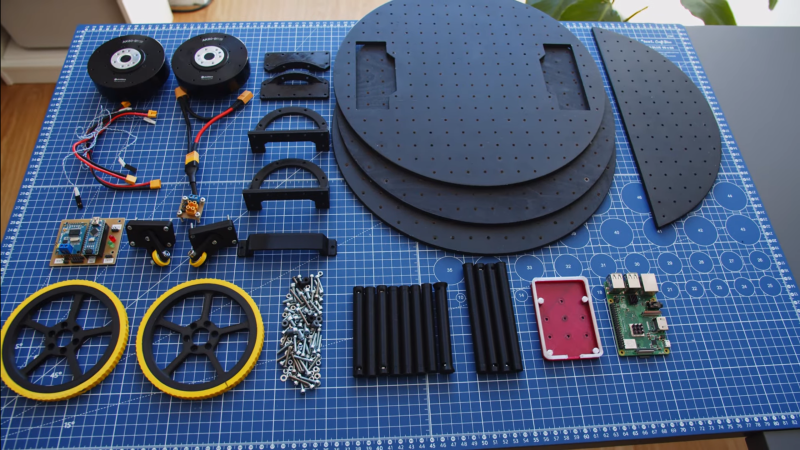On autonomous robots, the most difficult challenges usually lie in the software and electronic realms, but the mechanics can also be very time consuming. To help address this challenge, [Nikodem Bartnik] is working on the Open Robotic Platform (ORP), a modular robotics chassis system designed to make prototyping as easy and affordable as possible. Video after the break.
The ORP is governed by a set of design rules to maintain interchangeability. Most of the design rules are very open, but the cornerstone of ORP is its standardized mounting plates featuring a 20 mm grid pattern of 3.5 mm mounting holes. These plates can be stacked using connecting rods, creating a versatile foundation upon which various components can be mounted.
[Nikodem] is on a mission to create and collect an entire library of these modular components. From custom 3D-printed holders that accommodate sensors, motors, wheels and dev boards to homemade PCBs that snap directly onto the chassis, everything to get your robot rolling as soon as possible. While manufacturing methods and materials are not limited, 3D printing and laser cutting will likely be the most popular manufacturing technologies for making your own parts.
There are plenty of robotics platforms outdoor with different goals with STEM education and agriculture being popular. And of course don’t forget good old LEGO Mindstorms.

















Nice, I’ve done a little 10cm x 10cm one on the ORP rules. Just working on software for it now https://rosmo-robot.github.io/zio/
I watched the video, and I think this guy is on to something. Might I suggest someone contact vendors like #Pololu, #AdaFruit, #SparkFun, and #RobotShop, etc. to encourage them to adopt the standard and/or contribute their considerable expertise selling robot parts and chassis components. With luck, they have some opinions / improvements to offer “out of the gate.”
This is reminding me why standards bodies are valuable for some (and infuriating for others). Now with “openness” maybe things are different. (I am mostly familiar with software and electronics standards.)
Hi,
Nikodem here, the author of the video, thanks a lot for sharing!
If anyone is interested in getting an ORP chassis and supporting the project here is a link to the Kickstarter campaign: http://kck.st/3HF9Pyz
Thanks a lot and I am waiting for feedback about ORP!
Have a nice day!
It is a very good idea to have a standardizes system. My question would be: why 20×20?
It would be very good, if standard components e.g. LEGO could be attached. That would require dimensions of n x 8mm e.g. 16mm spacing.
n = 5
Where I went to school 5 x 8 = 40 so it takes a 2 x 20 grid pattern space. A simple subframe would make LEGO fit the pattern in that example.
Good point. Probably 40mm spacing is a little bit large.
Using LEGO pin connectors could also simplifying robot building (they are quite cheap and you can get them in pieces of 100).
https://www.brickina.eu/images/product_images/original_images/2780-04.jpg
They have 4mm diameter that is a little bit different than the 3mm screws. A solution could be to have alternately places holes for the pin connectors and the screws.
Correction: The LEGO hole diameter for the pin connects is 4.8mm
https://ullisroboterseite.de/nxt-dimension/liftarm.png
0.8 inch / 20mm is as close to a standard as you get with Sparkfun, Adafruit and others often using it as a mount hole dimension.
For example: https://learn.adafruit.com/adafruit-9-dof-orientation-imu-fusion-breakout-bno085/downloads
You could also use every other hole to connect to OpenStructures (40×40 mm): https://hackaday.com/2023/02/21/openstructures-is-a-modular-building-system-for-the-reprap-age/
I like the use of a standardized grid and have even done so myself. I have settled on a 60x60mm grid with M10 bolts for my CNC (and other) projects (With an option to go to 30x30mm). Standardizing on a thread size is a bit complicated. Thinner threads are easier to make, but also limited in strength, while the M10 bolts I use are very much oversized for smaller projects.
Take for example the M3 threads (for 3.5mm holes There probably is an equivalent in the banana units too) is just fine for mounting PCB’s and sensors and such, but for the construction of the frame itself it is quite fragile. Instead of the long plastic studs, it makes more sense to just use pieces of all thread and then clamp something in between.
I also thought of using this system to make bigger things from smaller things. If you use a grid of n*n on a rectangular plate, then make the plates: (Xn-1 by Yn-1) so you can combine the plates to make a bigger thing. Another useful extension is to either use aluminum or steel angle profile ( or square tubing) that is compatible with your grid. If you have a few pieces and drill (and optionally tap) holes in them, then it makes it easy to re-use these for other projects.
And of course: https://xkcd.com/927/ “goBILDA” profiles are based around an 8mm grid. I don’t know what the grid was of the old mechano stuff, but the idea is very similar, and so are the aluminimum profiles from makeblock.
And also: Materials like plywood are cheap and easy to cut to size. For a lot of projects it makes more sense to just saw them to size and glue them together instead of going though the extra effort of making it reusable.
I have a grid like that, that I use to organize the tools in my garage. The holes are spaced a little wider, at just over 25 mm. (25.4 mm to be exact) The board came pre-drilled from a local hardware store, and I have seen a few robotics projects using it.
I still have something similar from my childhood in the 60’s. It’s called an Erector set (or Meccano if you lived in another part of the world). Made quite a few robots, but sadliy without electronics.
The ORP library area seems to contain only STEP and printable formats, but no sources. … But why?